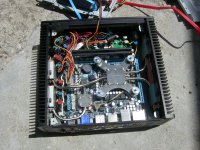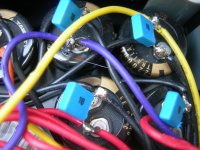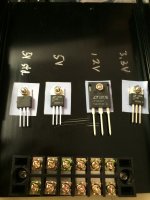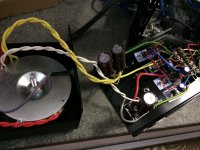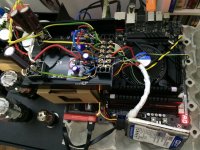I should have added "sounding" after "best". The Berkeley product is held in extremely high regard. Take a look at the reviews and chat to those that own one. Why? Berkeley would argue a number of things including better galvanic isolation from the source device and very high quality clocking. In any event, the point I was making remains the same. If you are heading down the USB route AND achieve proper galvanic isolation (at either your USB->SPDIF converter or USB DAC) from the source device then the source device power supply doesn't matter and isn't worth investing in. I, on the other hand, am dependent on SPDIF from the source and so care a lot about the audio server's power supply, clocks etc.
One bit at a time. If we cannot design the MB, let's at least do what we can.
A Intel based MB are not the first design to start with
For Intel systems I used cabinets from: Impactics | Keep It Simple, Silent and Smart
Finish and function are very good.
If I remember correctly I added a total of 130.000uF to the various voltages.
I have several slightly different systems (different MBs, different CPUs etc.) and I could bring a couple of them and compare to your version. Even if there are not Windows installed it would only take some minutes to clone an SSD drive and run your setup. Attached photo of the packed cabinet..
But a ARM based MB with all "not to be used" hardware removed are possible to design and build..
I have had a custom ARM based MB made by a manufacturer as I wanted more than the "normal" 1GB RAM etc.. There are still hardware onboard that I do not need for a music player system, but that will soon be removed. Then I will rebuild all regulators to my JFET regulators and powered by a 180.000uF PSU.
There will be galvanic isolated SATA, gigabit network, USB will be totally removed as I will use the I2S (and I2C for control) with galvanic isolation and clocked from the DAC master clock synchronously.
The ARM CPU can be 1, 2 or 4 core.
There was simple reasons to why I switched to ARM from Intel for music player systems..
1. Much easier to compile a good Linux kernel (relative new and working code without support of all kind of old hardware that the Intel source code are packed with).
2. Better SQ already from the first compilation of standard code.
3. Only a watt or two in wasted heat.
4. I can design a complete ARM based music player as a plugin PCB in my DAC.
Attachments
I am using an ASRock Z87E-ITX with a Haswell 4570T low TDP processor. It barely gets going running JRiver and I could probably run it without case cooling. But I am not about to start messing with the board itself...that's way beyond my current skill set.
For now, I'm going to move ahead with regulating 17 or 19V input to a very high quality 12V (to the PicoPSU) and a Fidelity Audio Microclock 2 to replace the oscillators on my Juli@ XTe card. Later I may follow in Analog_sa's footsteps and move to a full ATXish supply.
For now, I'm going to move ahead with regulating 17 or 19V input to a very high quality 12V (to the PicoPSU) and a Fidelity Audio Microclock 2 to replace the oscillators on my Juli@ XTe card. Later I may follow in Analog_sa's footsteps and move to a full ATXish supply.
If you are heading down the USB route AND achieve proper galvanic isolation (at either your USB->SPDIF converter or USB DAC) from the source device then the source device power supply doesn't matter and isn't worth investing in.
Not sure what exactly constitutes "proper galvanic isolation", probably not what i use as transport PS is clearly audible. It is easy for me to add a second galvanic isolation before the second reclock, but also based on the same ubiquitous chips. I may try it.
It is entirely unclear why audible differences persist at this level, but they do. It may have not much to do with the digital signal chain, but rather with the general level of RF in the room. It seems i don't like having class D amps in the listening room, irrespective of whether they play or are merely powered up and have speaker cables connected. This may be similar.
Ray
You are so far ahead of the curve... again
Please do drop in whenever you are heading this way. I will be thrilled to see your creations.
Now, that i am no longer limited with the Exa's board lack of Linux drivers i have no reason to stick to Windows. Or to Intel.
No it is old news
My Intel systems have been retired as music playing systems since 14 months ago (built in the spring 2011) and are now used as video surveillance servers and as Linux servers for cross compiling Linux for my ARM systems, but I connect them from time to time for music test / evaluation purposes..
Works great with both Joro´s USB adapter and the Amanero.
The Amanero are a special configured variant with galvanic isolation and other improvements.
Is the Amanero a USB input card for a DAC?
I keep hounding Theta Digital to build a high-quality USB input module for their Casablanca III HD (which is my DAC).
Anyone have a view on the worth of the SoTM USB cards? It would seem to me that they're worthless if the DAC's USB input (or the USB->SPDIF converter if you have to go that way) is doing a good job of galvanic isolation.
I keep hounding Theta Digital to build a high-quality USB input module for their Casablanca III HD (which is my DAC).
Anyone have a view on the worth of the SoTM USB cards? It would seem to me that they're worthless if the DAC's USB input (or the USB->SPDIF converter if you have to go that way) is doing a good job of galvanic isolation.
Anyone have a view on the worth of the SoTM USB cards? It would seem to me that they're worthless if the DAC's USB input (or the USB->SPDIF converter if you have to go that way) is doing a good job of galvanic isolation.
Theory is one thing, practice - quite another
To the best of my knowledge all current PC based playback is in some way influenced by the quality of the PC. Hardware, power supplies, USB ports (if used), operating systems, drivers, playback software all are still audible.
This audibility was reduced significantly with galvanic isolation and two independent clock domains in my system, but wasn't completely eliminated.
Whatever is the reason for this is not obvious. Radiated noise between boards? Who knows?
As for the SoTM, it deals mostly with power supply issues, which should really be resolved in a more organised manner. It can probably be diy-ed quite successfully by modifying a cheap existing card but i personally don't see a point.
The future is clearly in what Ray is doing - getting an I2S stream off the main board without involving unnecessary layers of software and hardware. It seems like Raspberry Pi can already do this.
Modern dac chips do support I2S as interchip format, so once you have it, it is all you need. And obviously, a reclock. In the case of older R-2R dacs, some reformatting will be necessary but this should be easily possible entirely in software - the driver can be modified for any type of alignment. Or one can use Ian's kit for the conversion and reclocking.
As for galvanic isolation, it is most easily achieved exactly at the I2S stage.
I have long given up on commercial offerings in digital. Mostly due to the lack of flexibility. It would be different if there was a unified intercomponent protocol like I2S, but there isn't.
As for galvanic isolation, it is most easily achieved exactly at the I2S stage.
I have long given up on commercial offerings in digital. Mostly due to the lack of flexibility. It would be different if there was a unified intercomponent protocol like I2S, but there isn't.
Am I right in understanding that you would deploy these when you do not have low ESR capacitors?
I am planning to use the following low ESR capacitors for regulated 12V from 17V input: Mundorf M-lytic AG capacitors (22,000uF). Two ahead of the regulator and one after. Mundorf M-lytic AG Capacitors homepage
Are there advantages to be had from deploying decoupling caps in this setup? If so, any recommendations?
I am planning to use the following low ESR capacitors for regulated 12V from 17V input: Mundorf M-lytic AG capacitors (22,000uF). Two ahead of the regulator and one after. Mundorf M-lytic AG Capacitors homepage
Are there advantages to be had from deploying decoupling caps in this setup? If so, any recommendations?
Last edited:
It's not so simple. I personally do not like decoupling on analogue circuits unless it is really required for stability, but most people do. Not at all sure what the effect in this case would be. Keep in mind there are lots of electrolytics + decoupling caps on the MB. Just adding randomly more... who knows. It depends on transformer parameters too. There is a lot of theory, but if someone is actually measuring or modelling the Q-factor of the system as whole is very dubious. One can introduce new or increase existing resonances quite easily.
One way to take this decisions is to listen but it gets tiresome pretty quickly.
Otoh, the Mlytics are my favourite large electrolytics. It seems Mundorf are rebadging an industrial cap, but they are still good value for money. Tbh i don't know how audible are caps signatures in this place. And i am not sure i really want to find out. Life is too short and too expensive even without this knowledge
One way to take this decisions is to listen but it gets tiresome pretty quickly.
Otoh, the Mlytics are my favourite large electrolytics. It seems Mundorf are rebadging an industrial cap, but they are still good value for money. Tbh i don't know how audible are caps signatures in this place. And i am not sure i really want to find out. Life is too short and too expensive even without this knowledge
(Yes, I understand Mundorf is branding production from a factory in Germany. The ones I am sourcing are not branded Mundorf but are basically the same as the ones I linked to and from the same factory.)
Thanks
Ray
Ever thought of getting a bigger enclosure? ;-) How do you attach the caps? Looks like you simply stuck them to the enclosure with double-sided tape or something. I'm also intrigued as to what you've placed over each cap.
Cheers
Steve
With ARM based systems the sizes are so small that the whole ARM linux system can be put on a tiny PCB inside the DAC.
The caps in the Intel system was attached with double sided tape, and the small blue polypropylene 10nF caps have a 630 volt rating and 2000 volt/us slew rate.
With ARM based systems the sizes are so small that the whole ARM linux system can be put on a tiny PCB inside the DAC.
The caps in the Intel system was attached with double sided tape, and the small blue polypropylene 10nF caps have a 630 volt rating and 2000 volt/us slew rate.
Thanks.
Kemet caps?
Theory is one thing, practice - quite another
To the best of my knowledge all current PC based playback is in some way influenced by the quality of the PC. Hardware, power supplies, USB ports (if used), operating systems, drivers, playback software all are still audible.
This audibility was reduced significantly with galvanic isolation and two independent clock domains in my system, but wasn't completely eliminated.
Whatever is the reason for this is not obvious. Radiated noise between boards? Who knows?
As for the SoTM, it deals mostly with power supply issues, which should really be resolved in a more organised manner. It can probably be diy-ed quite successfully by modifying a cheap existing card but i personally don't see a point.
The future is clearly in what Ray is doing - getting an I2S stream off the main board without involving unnecessary layers of software and hardware. It seems like Raspberry Pi can already do this.
I agree with you especially the "galvanic isolation" paragraph. Lot of factors affects the sound from my experience, not just power supply, but also the motherboard, CPU, RAM, SSD, etc...
Back to the topic, I want say thank you here for your help and sharing of the linear power supply circuit. I just made one for my own and it works on my PC.
Next step is to mount it properly. I will post more photos when the final product is made.

Attachments
- Status
- This old topic is closed. If you want to reopen this topic, contact a moderator using the "Report Post" button.
- Home
- Source & Line
- Digital Source
- Linear ATX power supply
